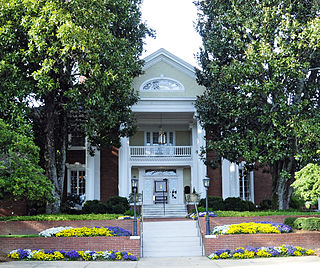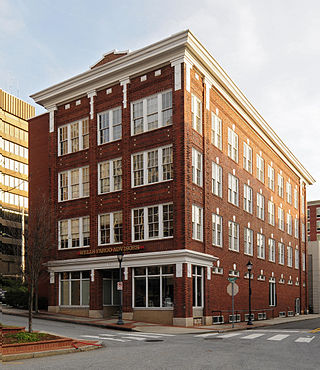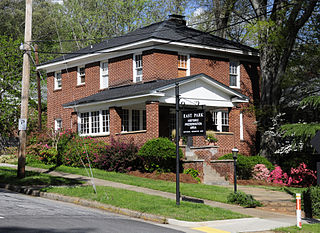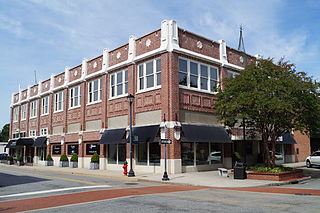Fisher Park is a neighborhood in the north central section of the United States city of Greensboro, North Carolina. Captain Basil J. Fisher turned a swamp into Greensboro's most fashionable Gilded Era address in 1901 when he donated the lowlands for a city park that bears his name. Residents took full advantage of ample lots overlooking the park by commissioning the city's best architects to design sometimes palatial homes. The neighborhood is recognized as Greensboro's first suburb, and is the city's most popular historic district.

Beaufort Historic District is a historic district in Beaufort, South Carolina. It was listed on the National Register of Historic Places in 1969, and was declared a National Historic Landmark in 1973.

Edenton Historic District is a national historic district located at Edenton, Chowan County, North Carolina. The district encompasses 342 contributing buildings, 4 contributing sites, and 3 contributing structures. It includes several buildings that are individually listed on the National Register. The Lane House, possibly the oldest surviving house in North Carolina, is owned by Steve and Linda Lane and is located within the district. Also located in the district are the Dixon-Powell House, William Leary House, and Louis Ziegler House designed by architect George Franklin Barber.
Glenwood or the Glenwood–Brooklyn Historic District is a historic neighborhood and national historic district located at Raleigh, North Carolina. The district encompasses 286 contributing buildings in an early-20th century streetcar suburb for working- and middle-class whites. Glenwood and Brooklyn were developed between about 1905 to 1951 and includes notable examples of Colonial Revival, Queen Anne, and Bungalow / American Craftsman style architecture. The houses are predominantly 1 1/2- and 2-story frame dwellings.

Hampton Heights is a neighborhood and historic district located in Spartanburg, South Carolina. Although the oldest existing home of the neighborhood dates to 1885, the majority of the homes in the neighborhood are from the 1900s to the 1930s. It is the oldest residential neighborhood in the city and one of the closest to Morgan Square, the historical center of Spartanburg. Although the neighborhood suffered from neglect and changing economics during the 1960s and 1970s, today it is a vibrant area undergoing restoration and improvement.

Pettigru Street Historic District is a historic tree-lined neighborhood east of Main Street in downtown Greenville, South Carolina. It is home to 88 structures built between 1890 and 1930 with the majority built between 1910 and 1930. It is known for its wide variety of architectural styles including Queen Anne, Colonial Revival, and Bungalow. The area is an example of evolution of architectural style from the Victorian era to the early 1930s similar to the growth in the city of Greenville as a whole during that time.

Columbia Historic District I is a national historic district located in the Arsenal Hill neighborhood at Columbia, South Carolina. The district encompasses nine contributing buildings and includes a complex of fine mansions and attractive homes built before the American Civil War. The buildings are in the Greek Revival, Italianate, Classical Revival, and the “Columbia Cottage” styles. They include the Governor's Mansion, Caldwell-Hampton-Boylston House, Lace House, and Palmetto Iron Works and Armory.

Columbia Historic District II is a national historic district located at Columbia, South Carolina. The district encompasses 113 contributing buildings and 1 contributing site in a former residential section of Columbia. They were built between the early-19th century and the 1930s and are now mostly used for commercial purposes. The buildings are in the Greek Revival, Gothic Revival, Classical Revival, and the “Columbia Cottage” styles. Notable buildings include the Robert Mills House, Debruhl-Marshall House, Hampton-Preston House, Episcopal Church of the Good Shepherd, Crawford-Clarkson House, Maxcy Gregg House, Hale-Elmore-Seibels House, St. Paul's Lutheran Church, and Ebenezer Lutheran Church.

The Lanneau-Norwood House is a historic, late 19th-century house on Belmont Avenue in Greenville, South Carolina. The house is an outstanding example of Second Empire architecture in the American South and is one of the last surviving Victorian-era homes in Greenville. The property was added to the National Register of Historic Places in 1982.

Carolina Supply Company is a historic commercial building located at Greenville, South Carolina. It was built in 1914, and is a four-story, brick building in a utilitarian Renaissance Revival style. The building housed a textile and industrial supply company that supplied mills with equipment and supplies. The building now houses Wells Fargo Bank.

Col. Elias Earle Historic District is a national historic district located at Greenville, South Carolina. It encompasses 74 contributing buildings in a middle-class neighborhood of Greenville. The houses primarily date from about 1915 to 1930, and include Neoclassical, Colonial Revival, Tudor Revival, and bungalow styles. The district was originally part of the estate of Colonel Elias Earle, a prominent early-19th century Greenville citizen. The Earle St. Baptist Church is located in the district.

West End Commercial Historic District is a national historic district located at Greenville, South Carolina. It encompasses 15 contributing buildings in Greenville's second "downtown." The commercial buildings primarily date from about 1880 to 1920, and include examples of Victorian commercial architecture. Notable buildings include the American Bank, Alliance and Mills & McBayer Cotton Warehouses, Indian River Fruit Store, Pete's Place, Bacot's West End Drug Store/Stringer's Drug, Furman Lunch, and Greer Thompson Building.

East Park Historic District is a national historic district located at Greenville, South Carolina. It encompasses 121 contributing buildings, 1 contributing site, and 3 contributing structures in a middle- / upper-class neighborhood of Greenville. The houses date from about 1908 to 1950, and include Neoclassical, Colonial Revival, Tudor Revival, Victorian, American Foursquare, Prairie Style, and bungalow styles.

Charleston Navy Yard Officers' Quarters Historic District is a national historic district located at the former Charleston Naval Shipyard in North Charleston, South Carolina. It encompasses 24 contributing buildings, 2 contributing sites, 1 contributing structure, and 1 contributing object. The site represents development of the upper echelon of senior military housing, support structures, sports facilities and recreational landscape features from 1901 through 1945. The buildings reflect late Victorian and early-20th century eclectic designs including the Italianate, Neo-Classical, Italian Renaissance Revival, Colonial Revival, and the Works Progress Administration (WPA) designed Panama House style.
William Pinckney Reinhardt House, also known as the Pink Reinhardt House, Reinhardt-Sigmon House, and Sigmon House, is a historic home located near Maiden, Catawba County, North Carolina. It was built about 1845, and is a two-story, Greek Revival style frame dwelling. The front facade features center bay portico supported by two stuccoed-brick Doric order columns and a sophisticated Asher Benjamin-inspired doorway. It has a 1+1⁄2-story frame addition built in the 1920s. It is nearly identical to the neighboring Franklin D. Reinhardt House.

Fisher Park Historic District is a national historic district in the Fisher Park neighborhood, Greensboro, Guilford County, North Carolina. The district encompasses 541 contributing buildings, 2 contributing sites, and 44 contributing structures in a predominantly residential section of Greensboro. The houses were largely built between the 1900s and 1930s and include notable examples of Queen Anne, Colonial Revival, Gothic Revival, American Foursquare, and Bungalow / American Craftsman-style architecture. Located in the district are the separately listed Dixon-Leftwich-Murphy House, John Marion Galloway House, Julian Price House, and Latham-Baker House. Other notable buildings include the First Presbyterian Church (1928), Holy Trinity Episcopal Church (1922), Gant-McAlister House, and A.J. Schlosser House.

Greenville Commercial Historic District is a national historic district located at Greenville, Pitt County, North Carolina. The district encompasses 51 contributing buildings in the central business district of Greenville. It includes buildings dated from about 1914 to 1952 and notable examples of Greek Revival and Queen Anne style architecture. Located in the district and listed separately are the Pitt County Courthouse (1911) by Milburn, Heister & Company and U.S. Post Office (1913). Other notable buildings include the Proctor Hotel (1911), Montgomery Ward Department Store (1929), Dail-Hodges Building (1919), Blount Building (1924), Greenville Bank and Trust, Smith Electric Building, Greenville Municipal Building (1929) designed by Benton & Benton, Blount-Harvey Department Store (1923), White's Theater (1914), Charles Greene House (1860), and the Robert Lee Humber House (1895).

The Hanckel-Barclay House, also known as Chestnut Hill, is a historic house in the Dunn's Rock community near Brevard, Transylvania County, North Carolina, bordered by the French Broad River and US Highway 276. The house was listed on the National Register of Historic Places in 1999.

Mordecai Place Historic District is a historic neighborhood and national historic district located at Raleigh, North Carolina. The district encompasses 182 contributing buildings and 1 contributing object in the most architecturally varied of Raleigh's early-20th century suburbs for the white middle-class. Mordecai Place was listed on the National Register of Historic Places in February 1998, with a boundary increase in 2000.




















